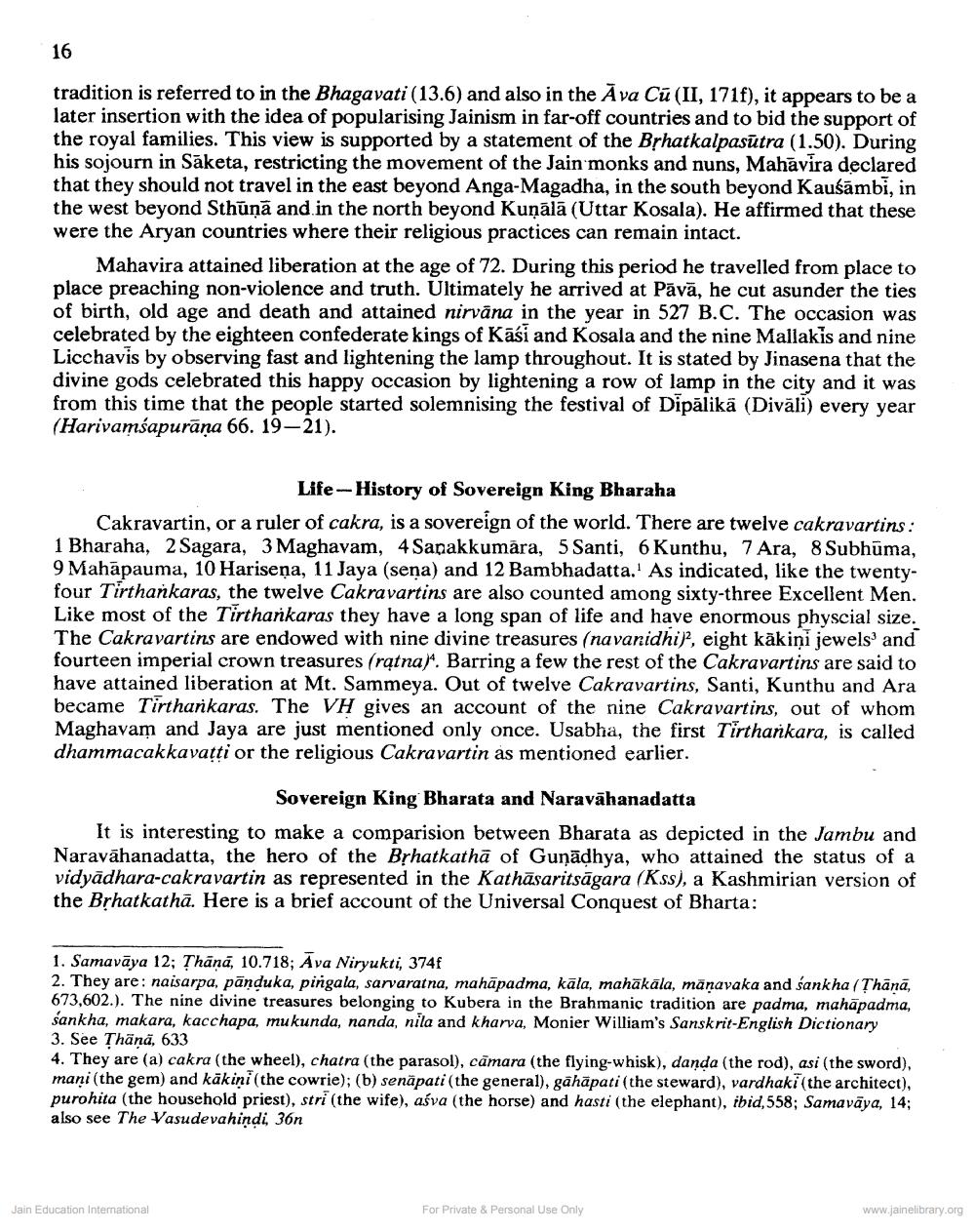________________
tradition is referred to in the Bhagavati (13.6) and also in the Āva Cū (II, 171f), it appears to be a later insertion with the idea of popularising Jainism in far-off countries and to bid the support of the royal families. This view is supported by a statement of the Brhatkalpasūtra (1.50). During his sojourn in Sāketa, restricting the movement of the Jain monks and nuns, Mahāvira declared that they should not travel in the east beyond Anga-Magadha, in the south beyond Kaušāmbi, in the west beyond Sthūņā and in the north beyond Kuņālā (Uttar Kosala). He affirmed that these were the Aryan countries where their religious practices can remain intact.
Mahavira attained liberation at the age of 72. During this period he travelled from place to place preaching non-violence and truth. Ultimately he arrived at Pāvā, he cut asunder the ties of birth, old age and death and attained nirvāna in the year in 527 B.C. The occasion was celebrated by the eighteen confederate kings of Kāśi and Kosala and the nine Mallakis and nine Licchavis by observing fast and lightening the lamp throughout. It is stated by Jinasena that the divine gods celebrated this happy occasion by lightening a row of lamp in the city and it was from this time that the people started solemnising the festival of Dipālikā (Diväli) every year (Harivamsapurana 66. 19-21).
Life - History of Sovereign King Bharaha Cakravartin, or a ruler of cakra, is a sovereign of the world. There are twelve cakravartins: 1 Bharaha, 2 Sagara, 3 Maghavam, 4 Sanakkumāra, 5 Santi, 6 Kunthu, 7 Ara, 8 Subhūma, 9 Mahāpauma, 10 Hariseņa, 11 Jaya (sena) and 12 Bambhadatta. As indicated, like the twentyfour Tirthařkaras, the twelve Cakravartins are also counted among sixty-three Excellent Men. Like most of the Tirtharkaras they have a long span of life and have enormous physcial size. The Cakravartins are endowed with nine divine treasures (navanidhi), eight kākini jewels and fourteen imperial crown treasures (ratna). Barring a few the rest of the Cakravartins are said to have attained liberation at Mt. Sammeya. Out of twelve Cakravartins, Santi, Kunthu and Ara became Tirtharikaras. The VH gives an account of the nine Cakravartins, out of whom Maghavam and Jaya are just mentioned only once. Usabha, the first Tirthankara, is called dhammacakkavatti or the religious Cakravartin as mentioned earlier.
Sovereign King Bharata and Naravāhanadatta It is interesting to make a comparision between Bharata as depicted in the Jambu and Naravāhanadatta, the hero of the Bșhatkathā of Guņādhya, who attained the status of a vidyādhara-cakravartin as represented in the Kathāsaritsāgara (Kss), a Kashmirian version of the Brhatkathā. Here is a brief account of the Universal Conquest of Bharta:
1. Samavāya 12; Thāna, 10.718; Ava Niryukti, 374 2. They are: naisarpa, pāņduka, pirgala, sarvaratna, mahāpadma, kāla, mahākāla, mānavaka and sankha (Thānā, 673,602.). The nine divine treasures belonging to Kubera in the Brahmanic tradition are padma, mahāpadma, sankha, makara, kacchapa, mukunda, nanda, nila and kharva, Monier William's Sanskrit-English Dictionary 3. See Thänä, 633 4. They are (a) cakra (the wheel), chatra (the parasol), câmara (the flying-whisk), danda (the rod), asi (the sword), mani (the gem) and käkini (the cowrie); (b) senapati (the general), gāhāpati (the steward), vardhaki(the architect), purohita (the household priest), stri (the wife), aśva (the horse) and hasti (the elephant), ibid, 558; Samavāya, 14; also see The Vasudevahindi, 36n
Jain Education International
For Private & Personal Use Only
www.jainelibrary.org




